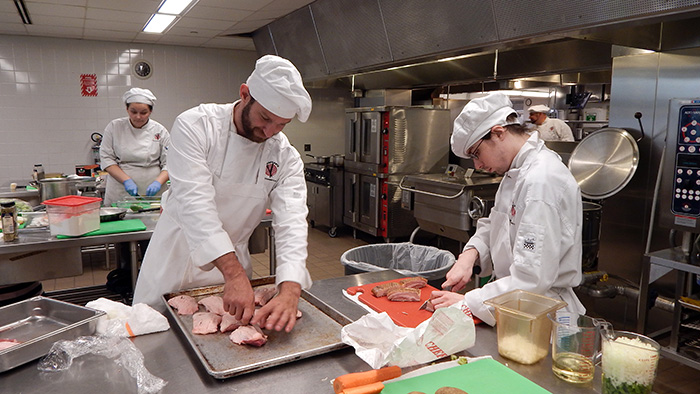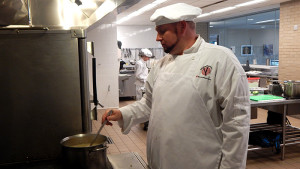 If you haven’t had a class on the fourth floor of Building 13, you most likely haven’t viewed the extensive stainless steel kitchen surrounded by glass windows. During various hours of the day, you can see students clad in all white chef attire including white berets doing the same thing we’re all here to do, learn.
If you haven’t had a class on the fourth floor of Building 13, you most likely haven’t viewed the extensive stainless steel kitchen surrounded by glass windows. During various hours of the day, you can see students clad in all white chef attire including white berets doing the same thing we’re all here to do, learn.
The Culinary Arts program is a part of the Hospitality Management and Tourism program, which has many programs under it. Besides Culinary Arts, others include Bakery and Pastry Arts, which focuses on crafting and creating breads and pastries, Lodging (which prepares students for work in hotels and resorts), Meeting and Event Planning (which also focuses on hotels and resorts, but expands to conventions), private clubs and corporate centers (which keeps their focus on event operations), and lastly, Tourism (which helps develop skills for travel planning and even has a short-term certificate for people looking to become a flight attendant).
All of these programs will end with an Associate Degree of Applied Science. But there are also a few short-term certificate programs, such as, the one for Food Service Management which is 35 credit hours long and wouldn’t be enough for an Associate Degree, but helps toward that goal and also gives preparation for the workforce.
The Culinary Arts program requires 69 credit hours and has a prerequisite of HMT 1107, which is “Sanitation and Safety.” The program provides the basics for a student to develop the skills to become a certified chef and teaches the importance of proper food preparation, as well as presentation
 There are six major goals for the Culinary Arts Program listed on their website that are important for students to be able to do upon completion. First, they want to be able to apply the fundamentals of baking science to the preparation of products. Second, become familiar with varieties of alcoholic and non-alcoholic beverages and explain the laws related to alcohol service. Third, to be able to perform mathematical functions related to food. Fourth, to apply principles of preparation and cooking techniques to produce a variety of hot and cold foods. Fifth, to have the knife skills to produce a variety of cuts and to be able to handle kitchen equipment safely and correctly. And last, to be able to perform dining room duties using a variety of styles to demonstrate quality customer service.
There are six major goals for the Culinary Arts Program listed on their website that are important for students to be able to do upon completion. First, they want to be able to apply the fundamentals of baking science to the preparation of products. Second, become familiar with varieties of alcoholic and non-alcoholic beverages and explain the laws related to alcohol service. Third, to be able to perform mathematical functions related to food. Fourth, to apply principles of preparation and cooking techniques to produce a variety of hot and cold foods. Fifth, to have the knife skills to produce a variety of cuts and to be able to handle kitchen equipment safely and correctly. And last, to be able to perform dining room duties using a variety of styles to demonstrate quality customer service.
Alexander Slaney, a student who is taking Culinary Arts more or less for his own personal education, said that the classes are “…really informative, the way that they’re set up, it’s definitely well thought out.”
He went on to explain that the intro level classes cover a lot of techniques and focus on practicing skills that are useful in either a personal at-home setting or in a professional setting.
Something non-Culinary Arts students may be interested in is the Tartan Terrace, located in Building 13. This serves as a “fine dining” facility, where Culinary Arts and Hospitality Management students can practice like it’s a learning lab. Reservations are required by anyone wanting to dine there and can be done through the Hospitality Management website. Lunch is served at noon and dinner is served at 6:00 p.m. and prices range from 10 to 15 dollars per person depending on if it’s lunch or dinner. The website also has the menu so you can see what is being prepared on each day.
Whether you are focused on a career in cooking or just want to develop skills for home, many students and faculty highly recommended the Sinclair’s Culinary Arts program.
Nick Felts
Staff Writer

